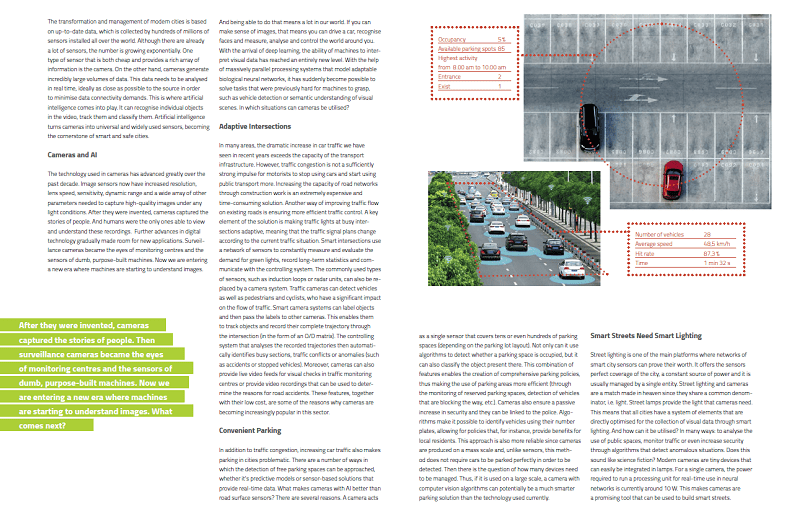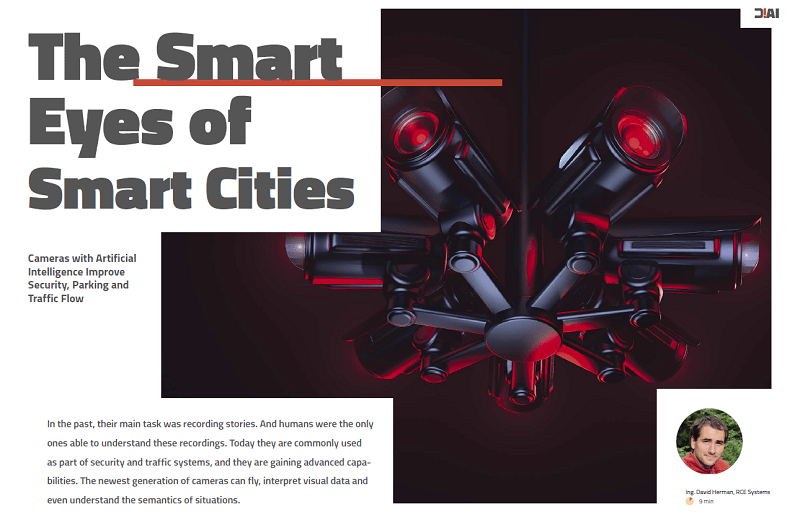Can something as common as a camera be transformed into a complex mobile monitoring system for advanced analysis of traffic? Can we distinguish anomalous and aggressive behavior of drivers, acquire full trajectories of vehicles or even detect traffic accidents before they happen? These are some of the questions that the newest edition of a smart city magazine called D!CITY tries to answer, which included also two smart city solutions using cameras: DataFromSky and ParkingDetection and also smart city platform of our partner OMS Lighting.
In the past, the main task for cameras was to record stories, which could be, unfortunately, interpreted only by humans. Nowadays, thanks to the increasing availability of high-quality cameras and mainly due to the immense technological advancement in the field of artificial intelligence and machine learning, the camera has become a universal sensor with application in many fields of the smart city concept, as they can serve as “the smart eyes of smart cities”. This marks the beginning of a new era, where image can be processed also by machines and where camera represents a rich source of data at even very low costs. What are the main areas of traffic analysis, where a camera already proves itself in action?
In times where individual transport increases faster than ever before, traffic congestions or even collapses can occur on a daily basis. Fortunately, there are systems which can help to achieve more fluent traffic even without expensive infrastructure changes, you just need a certain bird’s eye view. If we give camera “wings”, for example by attaching it to an unmanned aerial vehicle, we get a monitoring system for advanced traffic analysis which is not only very accurate but also at an affordable price. This is exactly what our project DataFromSky deals with – as there are several research projects that require just this type of traffic analysis. The system can detect vehicles and other participants of the traffic flow, which includes not only their trajectories and speed but also detection of possibly dangerous behavior with deep-learning and artificial intelligence. This can even detect traffic accidents before they actually happen, which can provide the traffic engineers with very valuable data about causes of traffic accidents within the tested area in order to look for ways how to avoid them in the future with convenient preventive measures.

Cameras are becoming a prominent technology for traffic analysis also at so-called “adaptive intersections”, as they can accurately detect not only vehicles, but also pedestrians and cyclists, which also play an important role in the given traffic flow. With smart traffic lights control, based on data from a network of sensors, the whole system becomes way more fluent and flexible when it comes to reaction to rapid changes within the traffic, making it also a lot safer. Another use of cameras lies in the field of smart lighting, as the camera can collect visual data and use to analyze public spaces, monitor traffic or detect anomalous behavior. This gives us many possibilities of designing smart streets with the use of a smart camera system, using something as common as public lighting.
Traffic congestion can be also caused by the situation in parking, especially in situations when drivers are trying to find an empty parking space in an infrastructure, which is already overloaded. One of the possible solutions is to use current parking spots more effectively or even navigate drivers to parking lots with available places to park their car. This is the main area of focus of the system called ParkingDetection. As far as technical and economic aspects are concerned, a camera represents a suitable sensorial solution for monitoring of even tens or hundreds of parking spots, as even very large parking lots can be covered by a single smart camera at very low costs, while magnetic sensors would be extremely expensive and even less accurate. If we also add an ALPR camera for number plate reading into the system, we get a significant number of potential technical solutions for residential parking, reservation of individual parking spots or even increased safety within the parking lot.

Are we on the brink of an age of cameras? In the not-so-distant past, autonomous vehicles, or using drones for traffic analysis would sound like science fiction. Nowadays, these technologies are already becoming a reality, also thanks to the advancement in cameras and artificial intelligence. It is becoming clear that cameras will play an important role in the future of smart cities.
The whole magazine can be found at this link.



